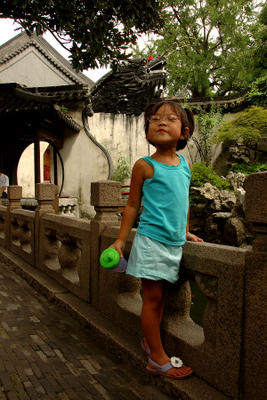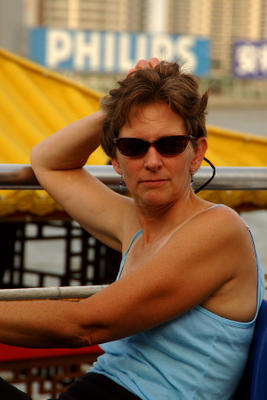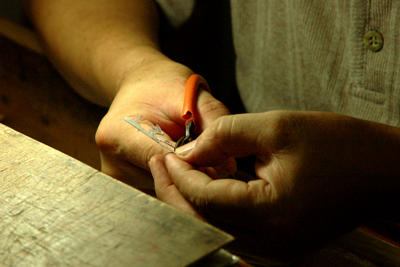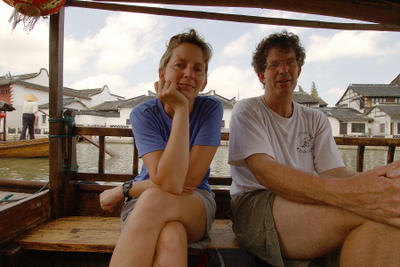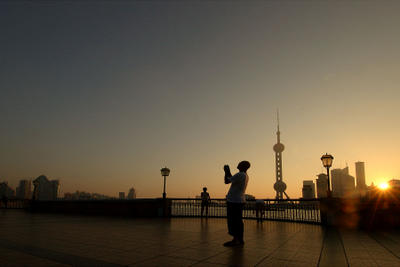Checking Out Lijiang
28 August 2005
We've been in Lijiang for just a few days now and already I'm way behind on getting photos organized and put up here. We've been busy--in a kind of relaxed way. Since arriving here last Tuesday we've set up our nice little two room apartment, learned how to buy food in open markets, purchased bicycles, started doing laundry by hand, visited villages and strained for glimpses of the mountains through rainy season clouds. Classes start here this week, so our lives will get a little scheduled and a lot busier, but hopefully not TOO busy. Ellen doesn't start teaching until September 13th or so, since her classes are all for freshmen and they are in military training until then. I'm not so lucky and my first classes are on Tuesday. For now I'm teaching 2 sections of writing and 1 of "English newspaper and magazine reading". Maybe I'll just log onto the New York Times and let them read for 2 hours each week while I drink coffee? I'll pick up additional oral English hours after the 13th. The campus is new and pretty nice--a little sterile relative to city life in China, but quiet and well appointed. We're about 3 or 4 km north of Lijiang itself (a quick bus ride on Bus #11 for 5 cents) and a few km from some other small villages that we really like. We have the option of someday moving off campus and we may take it next semester but for now this feels comfortable.
I'll post up some photos below to give you a sense of the place--it's beautiful and we're just starting to scratch the surface so I'm wired about being here. Ellen shakes her head as I scheme about where we can rush off to each day since we have a whole year to take it in, but I can't help myself.
Here's a view from the hill behind campus looking southwest. Campus is the closest group of buildings (mostly white)and Lijiang is down to the south. There are some old pagodas on the very tops of the hills above Lijiang that we haven't hiked to yet. The valley itself is mostly agricultural. They grow lots of corn and rapeseed (canola) and some other plants too. More on that in a later blog.
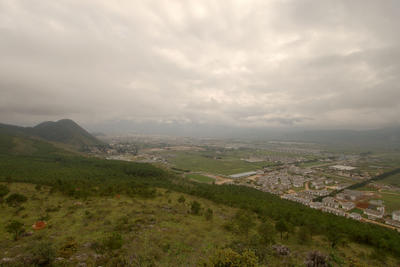
It's the rainy season and it rains almost every day although the last couple have not been too wet. These umbrellas were left outside a classroom meeting on campus.
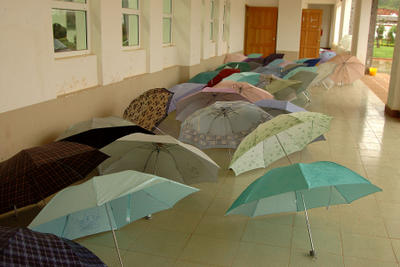
This is about as much as we’ve seen of Jade Dragon Snow Mountain, the 18,000 foot peak 30 km north of Lijiang. The view reminds me of being in Jackson and looking north to the Tetons except that there is 10,000 feet of relief instead of 6,000 feet and the peak is part of the Himalayas which sweep northward and westward from here into Tibet. And house prices are lower.

Lijiang is divided into two parts--new town and old town. The new town is a typical working Chinese city--pretty ugly with lots of concrete buildings and cell phone stores. The old town is utterly different. No cars are allowed on the narrow stone streets that follow clear flowing streams channeled within stone canals. The negative is that it is touristy and big groups of mostly Chinese and Japanese tourists wander around behind flag waving leaders shooting video of each other striking poses with people dressed in traditional clothes. It's a little hard to take. But if you wander very far into the town you lose most of the tourists and can enjoy the beauty of the place. This first picture is of Ellen and Bei high in old town away from the tourists.
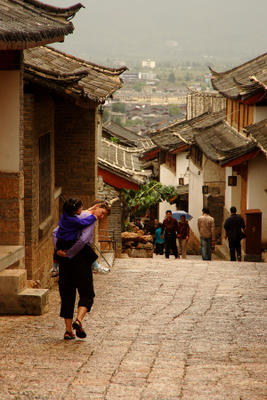
People here love kids and Bei is an attractant for meeting some great people. This guy with his little boy had fun checking Bei out.

Bei is loathe to walk very far even though in all other circumstances her energy is boundless. Ellen and I take turns carrying her around and she's starting to feel heavy at 32 pounds. We finally bought a backpack child carrier at an outdoor store here which is easier to carry than throwing her on your shoulders. We also bought a seat that goes on the back of our bikes so that she can ride with us on excursions.

The open market in new town is our source for vegetables now that we're learning how to buy things there. These little fellas aren't on our shopping list yet. And I'm hoping not to be presented with any in awkward eating situations. They also have the ubiquitous bowls of chicken feet and some ancient dusty pig meat in the market. The latter was wrapped in old cloth with just the little pig hooves sticking out and we figure it must be some kind of aged ham. We haven't tried that either.
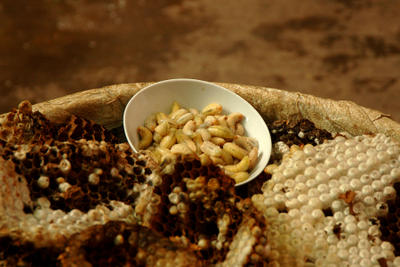
Our most recent discoveries are some smaller villages close to campus. The first one I found is called Shuhe (Sue-huh -- the local accent doesn't use the 'sh' sound) and is about a 15 minute bike ride from our apartment. It is somewhat touristy too, but not nearly as bad as old town Lijiang and the setting is gorgeous. The town sits up against the hills on the west side of the valley (we are on the east side here on campus) and the streams that flow through town are spring fed and absolutely clear. This first shot is a bridge in town with some tourists (umbrellas) and horses (4 legs). The horses are used both for real work and to give tourists rides.
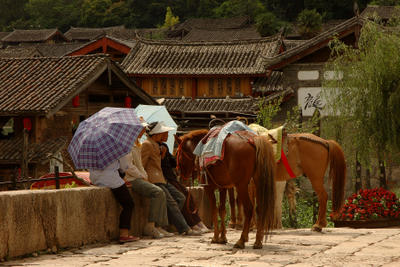
Here's a street scene in Shuhe. The water is channeled all over town and follows these beautiful stone walkways.

I walked through Shuhe town and out into the fields to the north one day and met 4 young girls playing there. This was the littlest one and she let me take her picture. Then they followed me around and had me take their pictures in various settings after which I could show them the shots on the back of my digital camera which they thought was great.

The houses are all roofed with tiles like these that I found stacked beside a shed in the hills behind town.

One street follows a clear flowing stream and sports a row of restaurants geared towards tourists. This is the beer cooler and I tested a beer for coldness. It passed. If you order chicken with dinner the cook runs up the hill and returns with a freshly killed bird that he cleans in the stream beside your table before taking it into the kitchen. Bei has learned that meat doesn't originate in plastic wrapped supermarket packages.

About 5 km north of campus is another little village called Baisha that is billed as the ancient center of the Naxi culture. It's less affected by tourists than Lijiang or Shuhe though there is some tourism there. I don't know much yet about the Naxi and will write more later when I do. They apparently have a loose matrimonial society in which women have multiple lovers and no real affinity to a husband. On the whole everyone seems to be enjoying themselves.

A doorway in Baisha.
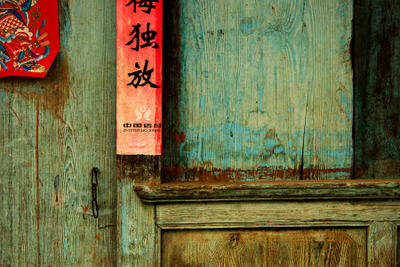
These are some typically dressed old Naxi women. They hang out like this on street corners though they also work really hard. There is a lot of hauling around of big baskets laden with sticks, pine needles and other things.

Here's a Naxi women hauling a typical load. Tony, an Australian teacher new here like us, told me that a friend of his in another part of China saw a woman carrying a big basket and noticed that smoke was coming out of it. He agonized a little and decided that he should alert her that her basket was on fire (maybe she'd picked up some still glowing coals?). Upon hearing the news the woman replied, "my basket is NOT on fire. My husband is having a smoke". I haven't seen anyone hauling their husbands around in this part of China but nothing would surprise me.
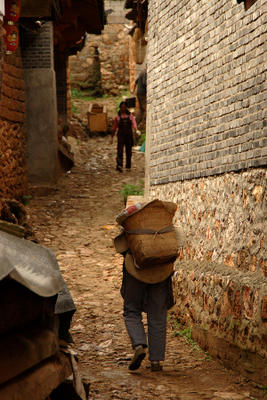
Here's another typical load (pine needles).
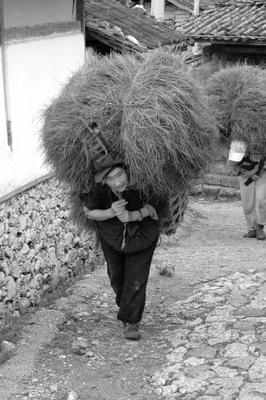
The Naxi our know for their "orchestras" and this little farmer band was playing in Baisha for the benefit of the tourists and for a small donation. Apparently the Naxi musical history is rich and draws from a Taoist liturgical tradition that I know nothing about. I'll probably learn more as time goes on.
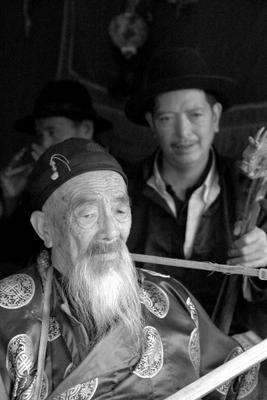
So, that's a quick look at the area within biking distance. I'm looking forward to getting below the touristy surface and into some of the more remote places around, but for now we have plenty to explore close by.
We've been in Lijiang for just a few days now and already I'm way behind on getting photos organized and put up here. We've been busy--in a kind of relaxed way. Since arriving here last Tuesday we've set up our nice little two room apartment, learned how to buy food in open markets, purchased bicycles, started doing laundry by hand, visited villages and strained for glimpses of the mountains through rainy season clouds. Classes start here this week, so our lives will get a little scheduled and a lot busier, but hopefully not TOO busy. Ellen doesn't start teaching until September 13th or so, since her classes are all for freshmen and they are in military training until then. I'm not so lucky and my first classes are on Tuesday. For now I'm teaching 2 sections of writing and 1 of "English newspaper and magazine reading". Maybe I'll just log onto the New York Times and let them read for 2 hours each week while I drink coffee? I'll pick up additional oral English hours after the 13th. The campus is new and pretty nice--a little sterile relative to city life in China, but quiet and well appointed. We're about 3 or 4 km north of Lijiang itself (a quick bus ride on Bus #11 for 5 cents) and a few km from some other small villages that we really like. We have the option of someday moving off campus and we may take it next semester but for now this feels comfortable.
I'll post up some photos below to give you a sense of the place--it's beautiful and we're just starting to scratch the surface so I'm wired about being here. Ellen shakes her head as I scheme about where we can rush off to each day since we have a whole year to take it in, but I can't help myself.
Here's a view from the hill behind campus looking southwest. Campus is the closest group of buildings (mostly white)and Lijiang is down to the south. There are some old pagodas on the very tops of the hills above Lijiang that we haven't hiked to yet. The valley itself is mostly agricultural. They grow lots of corn and rapeseed (canola) and some other plants too. More on that in a later blog.

It's the rainy season and it rains almost every day although the last couple have not been too wet. These umbrellas were left outside a classroom meeting on campus.

This is about as much as we’ve seen of Jade Dragon Snow Mountain, the 18,000 foot peak 30 km north of Lijiang. The view reminds me of being in Jackson and looking north to the Tetons except that there is 10,000 feet of relief instead of 6,000 feet and the peak is part of the Himalayas which sweep northward and westward from here into Tibet. And house prices are lower.

Lijiang is divided into two parts--new town and old town. The new town is a typical working Chinese city--pretty ugly with lots of concrete buildings and cell phone stores. The old town is utterly different. No cars are allowed on the narrow stone streets that follow clear flowing streams channeled within stone canals. The negative is that it is touristy and big groups of mostly Chinese and Japanese tourists wander around behind flag waving leaders shooting video of each other striking poses with people dressed in traditional clothes. It's a little hard to take. But if you wander very far into the town you lose most of the tourists and can enjoy the beauty of the place. This first picture is of Ellen and Bei high in old town away from the tourists.

People here love kids and Bei is an attractant for meeting some great people. This guy with his little boy had fun checking Bei out.

Bei is loathe to walk very far even though in all other circumstances her energy is boundless. Ellen and I take turns carrying her around and she's starting to feel heavy at 32 pounds. We finally bought a backpack child carrier at an outdoor store here which is easier to carry than throwing her on your shoulders. We also bought a seat that goes on the back of our bikes so that she can ride with us on excursions.

The open market in new town is our source for vegetables now that we're learning how to buy things there. These little fellas aren't on our shopping list yet. And I'm hoping not to be presented with any in awkward eating situations. They also have the ubiquitous bowls of chicken feet and some ancient dusty pig meat in the market. The latter was wrapped in old cloth with just the little pig hooves sticking out and we figure it must be some kind of aged ham. We haven't tried that either.

Our most recent discoveries are some smaller villages close to campus. The first one I found is called Shuhe (Sue-huh -- the local accent doesn't use the 'sh' sound) and is about a 15 minute bike ride from our apartment. It is somewhat touristy too, but not nearly as bad as old town Lijiang and the setting is gorgeous. The town sits up against the hills on the west side of the valley (we are on the east side here on campus) and the streams that flow through town are spring fed and absolutely clear. This first shot is a bridge in town with some tourists (umbrellas) and horses (4 legs). The horses are used both for real work and to give tourists rides.

Here's a street scene in Shuhe. The water is channeled all over town and follows these beautiful stone walkways.

I walked through Shuhe town and out into the fields to the north one day and met 4 young girls playing there. This was the littlest one and she let me take her picture. Then they followed me around and had me take their pictures in various settings after which I could show them the shots on the back of my digital camera which they thought was great.

The houses are all roofed with tiles like these that I found stacked beside a shed in the hills behind town.

One street follows a clear flowing stream and sports a row of restaurants geared towards tourists. This is the beer cooler and I tested a beer for coldness. It passed. If you order chicken with dinner the cook runs up the hill and returns with a freshly killed bird that he cleans in the stream beside your table before taking it into the kitchen. Bei has learned that meat doesn't originate in plastic wrapped supermarket packages.

About 5 km north of campus is another little village called Baisha that is billed as the ancient center of the Naxi culture. It's less affected by tourists than Lijiang or Shuhe though there is some tourism there. I don't know much yet about the Naxi and will write more later when I do. They apparently have a loose matrimonial society in which women have multiple lovers and no real affinity to a husband. On the whole everyone seems to be enjoying themselves.

A doorway in Baisha.

These are some typically dressed old Naxi women. They hang out like this on street corners though they also work really hard. There is a lot of hauling around of big baskets laden with sticks, pine needles and other things.

Here's a Naxi women hauling a typical load. Tony, an Australian teacher new here like us, told me that a friend of his in another part of China saw a woman carrying a big basket and noticed that smoke was coming out of it. He agonized a little and decided that he should alert her that her basket was on fire (maybe she'd picked up some still glowing coals?). Upon hearing the news the woman replied, "my basket is NOT on fire. My husband is having a smoke". I haven't seen anyone hauling their husbands around in this part of China but nothing would surprise me.

Here's another typical load (pine needles).

The Naxi our know for their "orchestras" and this little farmer band was playing in Baisha for the benefit of the tourists and for a small donation. Apparently the Naxi musical history is rich and draws from a Taoist liturgical tradition that I know nothing about. I'll probably learn more as time goes on.

So, that's a quick look at the area within biking distance. I'm looking forward to getting below the touristy surface and into some of the more remote places around, but for now we have plenty to explore close by.
















